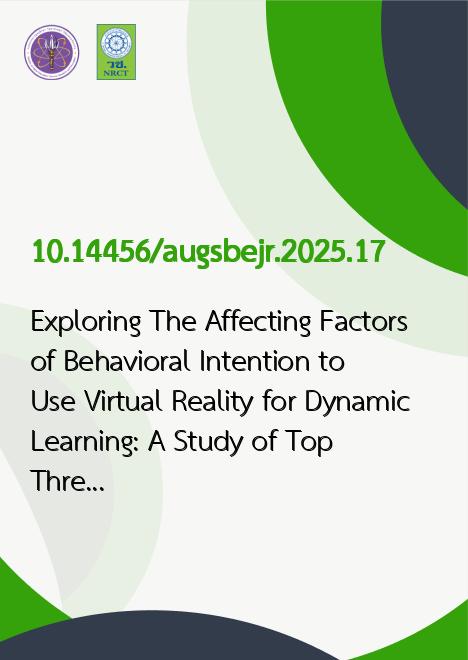
|
Exploring The Affecting Factors of Behavioral Intention to Use Virtual Reality for Dynamic Learning: A Study of Top Three Private Universities in Yangon, Myanmar |
|---|---|
| รหัสดีโอไอ | |
| Creator | Nang Winterlongqueau Long Queau |
| Title | Exploring The Affecting Factors of Behavioral Intention to Use Virtual Reality for Dynamic Learning: A Study of Top Three Private Universities in Yangon, Myanmar |
| Publisher | Assumption University Press |
| Publication Year | 2568 |
| Journal Title | AU-GSB e-Journal |
| Journal Vol. | 18 |
| Journal No. | 1 |
| Page no. | 170-182 |
| Keyword | Performance Expectancy, Effort Expectancy, Social Influence, Behavioral Intention, Virtual Reality |
| URL Website | http://www.assumptionjournal.au.edu/index.php/AU-GSB/article/view/7890 |
| Website title | AU-GSB e-Journal |
| ISSN | 1906-3296 |
| Abstract | Purpose: This research aims to examine the factors affecting the students, behavioral intentions towards using virtual reality technology in replacing online learning/eLearning platforms to better engage in dynamic learning with the studies and improve their learning journey. The key variables are performance expectancy, perceived usefulness, perceived enjoyment, effort expectancy, social influence, perceived ease of use, hedonic motivation, attitude toward technology, and behavioral intention. Research design, data, and methodology: The quantitative questionnaire survey was provided to the target population of 500 students who are currently attending or have been attending the selected top three private universities of Yangon, Myanmar. The sampling techniques involve judgmental, snowball, quota, and convenience. Confirmatory factor analysis (CFA) and structural equation modeling were applied to analyze the data. Results: Perceived enjoyment has a significant effect on perceived usefulness, and attitude toward technology using VR. Effort expectancy Hedonic motivation and social influence significantly affect behavioral intention to use VR. However, there are no significant support between the relationship between performance expectancy, perceived usefulness, attitude toward technology using, perceived ease of use and behavioral intention to use VR. Conclusion: From the studies, the researcher can indicate that using new technology is useful and enjoyable for the users/students. |
